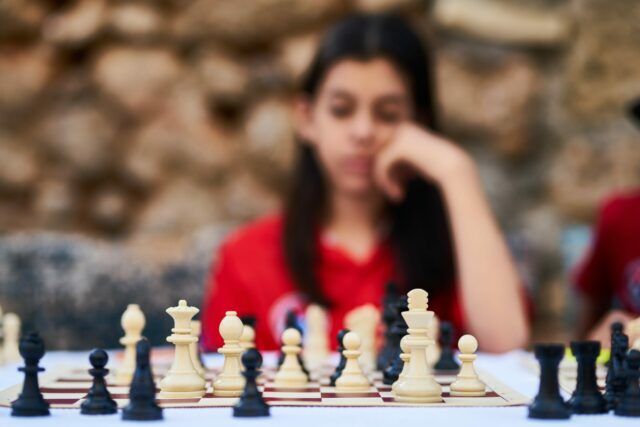Welcome to the captivating world of chess, where strategy and tactics intertwine to create a battle of wits on the 64-square battlefield. Among the many skills that separate a novice from a skilled player is the ability to control the center of the chessboard.
In this article, we delve into the depths of chess mastery and explore the key principles and techniques that will empower you to establish dominance in the heart of the game.
Why is the center of the chessboard so crucial?
The center of the chessboard holds the key to unlocking a world of possibilities. It acts as a strategic powerhouse, allowing you to exert influence over the entire board. By occupying and controlling the center squares, you gain a vital vantage point from which to launch attacks, execute intricate maneuvers, and dictate the flow of the game.
The center’s significance lies in its ability to provide ample mobility for your pieces, enabling swift coordination, effective defense, and potent counterattacks. Without a firm grip on the center, your options become limited, and your opponent gains a significant advantage.
What are the benefits of controlling the center?
Controlling the center bestows upon you a plethora of advantages that can tilt the scales of victory in your favor. Firstly, it grants you greater control over the board’s crucial avenues, allowing you to influence the direction of the game and restrict your opponent’s options.
Additionally, dominating the center enhances the mobility and coordination of your pieces, enabling them to reach key squares and launch powerful attacks with ease.
Center control also facilitates the development of your pieces, providing them with optimal routes to engage in both offensive and defensive maneuvers. Moreover, it affords you a stronger presence in the middle and endgame, allowing for smoother transitions and increasing your chances of emerging victorious.
How does the center influence the outcome of a game?

The center exerts a profound influence on the outcome of a chess game, shaping the course of the battle and determining the fate of both players. When you establish control over the center, you create a commanding presence that can intimidate and confound your opponent.
This positional advantage enables you to seize the initiative, dictate the pace of the game, and set traps that can catch your opponent off guard. By securing the center, you gain greater access to key squares, which enhances your ability to launch powerful attacks, mount relentless pressure, and exploit vulnerabilities in your opponent’s position.
In contrast, surrendering the center allows your opponent to seize the initiative, restrict your options, and potentially launch devastating offensives that can be difficult to repel.
Which pieces are best suited for center control?
Certain pieces possess a natural affinity for center control, making them invaluable assets in your quest for dominance. The queen and the central pawns, particularly the d- and e-pawns, hold immense power when it comes to asserting control over the center.
Their mobility and range allow them to cover multiple central squares simultaneously, establishing a formidable presence that influences the entire board. Additionally, knights excel in maneuvering within the central area, thanks to their unique L-shaped movement.
Their ability to leap over obstacles and occupy critical squares makes them indispensable in the battle for center control. Finally, the rooks, while initially confined to the back rank, can play a crucial role in supporting the center, providing backup and reinforcement to other pieces seeking to establish a strong position.
Are there specific opening moves that help establish center control?
Indeed, certain opening moves are designed to facilitate the establishment of center control from the very beginning of the game. Moves such as 1.e4 and 1.d4 are commonly employed by players seeking to occupy the central squares with their pawns.
These moves not only stake a claim to the center but also pave the way for the development of other pieces. Other popular opening moves, such as 1.Nf3 and 1.c4, aim to indirectly influence the center by preparing to support pawn advances or facilitating piece development that can later challenge or reinforce center control.
What are the potential pitfalls of neglecting the center?
Neglecting the center can lead to disastrous consequences, leaving you vulnerable and at a significant disadvantage. By disregarding the importance of center control, you cede valuable territory to your opponent, allowing them to establish a dominant position and restrict your piece mobility.
Without a foothold in the center, your pieces can become confined to the sidelines, rendering them less effective in launching coordinated attacks or mounting a strong defense.
Furthermore, your opponent may seize the opportunity to expand their influence in the center, gaining greater control over critical squares and dictating the flow of the game. Neglecting the center can ultimately result in a compromised position, limited options, and an uphill battle to regain control.
How can pawn structure affect center control?

Pawn structure plays a crucial role in determining the success of center control strategies. The placement and movement of pawns directly impact the stability and influence of the center. A well-coordinated pawn structure, such as a solid pawn chain or a pawn duo, can bolster center control by creating a robust defensive barrier and establishing a strong foothold.
Conversely, a weakened or compromised pawn structure can undermine center control, leaving vulnerable weaknesses for your opponent to exploit.
Understanding how pawn moves affect the center allows you to make informed decisions about pawn breaks, exchanges, and pawn structure alterations, all of which can either fortify or weaken your grip on the central squares.
Are there any strategic sacrifices to gain control of the center?
In the pursuit of center control, strategic sacrifices can prove to be a powerful and dynamic tool. Sacrificing material, such as pawns or even pieces, can disrupt your opponent’s position, create openings, and pave the way for a swift and decisive assault on the center.
Sacrificial attacks can open lines, expose weaknesses, and generate tactical complications that your opponent may struggle to navigate. However, it is essential to assess the potential benefits and drawbacks of a sacrifice carefully.
Strategic sacrifices should only be employed when the resulting positional or tactical advantages outweigh the material loss, and there is a high likelihood of gaining a significant advantage in center control.
How do you maintain control of the center in the middle game?
Maintaining control of the center during the middle game requires strategic finesse and careful maneuvering. Firstly, it is crucial to keep your central pawns adequately supported and protected, preventing your opponent from easily undermining your control.
Additionally, piece development and coordination play a vital role in consolidating center control. By harmoniously deploying your pieces to key squares and maximizing their influence on the center, you can create a harmonious synergy that reinforces your position.
It is also essential to anticipate potential counterattacks or breakthrough attempts from your opponent and proactively address them through vigilant defense and tactical countermeasures.
What defensive measures can be employed to challenge center control?

When facing a formidable opponent who has established strong center control, several defensive measures can be employed to challenge their dominance. One effective strategy is to launch counterattacks from the flanks, exploiting the weaknesses created by their overextension in the center.
By targeting vulnerable areas and c, you can disrupt their coordination and force them to divert their attention away from further expanding their control.
Another defensive tactic is to focus on piece activity and maneuvering, aiming to develop your pieces harmoniously and position them strategically to challenge the opponent’s centralized forces.
Can you recover from losing control of the center?
Losing control of the center does not spell doom for your chances of victory. Chess is a game of dynamic shifts and constant strategic reevaluation. Even if your opponent establishes a stronghold in the center, there are various ways to stage a recovery. One approach is to focus on piece development and aim to contest the central squares with well-coordinated maneuvers.
By mobilizing your pieces effectively, you can challenge your opponent’s center control and create counterplay opportunities. Additionally, exploiting weaknesses created by their centralized position, such as pawn weaknesses or exposed squares, can enable you to launch tactical strikes and regain control.
Flexibility and adaptability are key, as you may need to adjust your strategy and find alternative paths to victory. With careful planning, resourceful play, and seizing opportunities, you can turn the tables and recover from a disadvantageous position in the center.
How does center control affect endgame positions?
Center control is not only crucial in the opening and middlegame but also carries significant weight in the endgame. The advantages gained from center control can be especially pronounced as the board becomes less crowded.
With fewer pieces on the board, the influence of centralized pawns and pieces increases, allowing for greater mobility and control. Possessing a strong center can facilitate the advancement of pawns toward promotion, as well as the creation of powerful passed pawns that can decide the outcome of the game.
Additionally, a dominant center can provide a solid base for launching decisive attacks or creating favorable tactical opportunities. Center control in the endgame can grant you an invaluable edge, enhancing your chances of achieving a favorable outcome and securing victory.
Are there any famous games that highlight the importance of center control?
Throughout the history of chess, numerous famous games have underscored the critical role of center control. One iconic example is the game between Wilhelm Steinitz and Johannes Zukertort in their 1886 World Championship match. Steinitz, known for his strategic mastery, demonstrated the power of center control by consistently reinforcing his position in the center, denying Zukertort any foothold.
Steinitz’s dominance in the center allowed him to launch a devastating kingside attack and secure a resounding victory. Another notable game is the encounter between Anatoly Karpov and Garry Kasparov during their 1984 World Championship match.
Kasparov skillfully wrestled control of the center from Karpov, leveraging his superior piece coordination and central pawn structure to dictate the flow of the game and ultimately triumph.
What psychological advantages does center control provide?
Center control offers a range of psychological advantages that can significantly influence the dynamics of a chess game. Firstly, it instills a sense of confidence and authority, as occupying the center empowers you to set the terms of engagement and dictate the flow of the game.
By asserting dominance in the heart of the board, you impose psychological pressure on your opponent, making them feel restricted and confined in their options. Center control also creates a perception of superiority, as it symbolizes a position of strength and strategic prowess.
This psychological advantage can cause your opponent to become defensive, cautious, or even make mistakes in their attempts to challenge your control. Additionally, center control enhances your ability to launch surprise attacks, launch double threats, and exploit tactical opportunities, further amplifying the psychological pressure on your opponent.
How can practicing center control improve overall chess skills?
| Strategy | Advantages | Disadvantages |
|---|---|---|
| Occupying the center with pawns |
|
|
| Controlling the center with pieces |
|
|
| Using central pawns as a springboard |
|
|
| Establishing strong central outposts |
|
|
| Initiating pawn breaks in the center |
|
|
Practicing center control not only enhances your understanding of strategic concepts but also improves your overall chess skills in various aspects. It sharpens your tactical acumen by providing ample opportunities for tactical combinations, forcing you to calculate accurately and identify tactical patterns.
Center control also deepens your understanding of piece coordination and harmonious development, as it requires careful planning and maneuvering to establish a cohesive position.
Additionally, center control nurtures your ability to anticipate and respond to dynamic changes in the game, fostering adaptability and flexibility. Finally, the practice of center control cultivates a strategic mindset, honing your decision-making skills and promoting long-term planning.
Final thoughts
In conclusion, center control in chess is not merely a concept but a powerful strategy that can tip the scales in your favor. Mastering the art of controlling the center unlocks a wealth of advantages, from increased mobility and coordination to dictating the flow of the game.
Through understanding the significance of the center, employing defensive measures, recovering from losses, and leveraging its influence in the endgame, you can seize the initiative, launch devastating attacks, and secure victories. Famous games throughout history exemplify the importance of center control, while the psychological advantages it provides add an extra dimension to your strategic arsenal.
So, embrace the challenge, embrace the center, and embark on a journey to become a formidable chess player who dominates the heart of the board.




